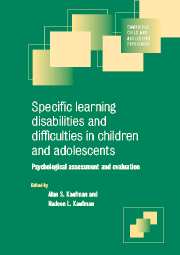 Specific Learning Disabilities and Difficulties in Children and Adolescents
Specific Learning Disabilities and Difficulties in Children and Adolescents from Part I - History and Tradition
Published online by Cambridge University Press: 06 January 2010
The Wechsler intelligence scales are individually administered, composite batteries which measure a wide range of intellectual abilities. Given the diversity of abilities measured, they are often perceived as being well suited for the assessment of learning disabilities. Accordingly, they have become some of the most extensively used and time-honored tools in learning disabilities assessment. In order to evaluate their relevance for this task, it is essential both to provide a complete description of the instruments and, more importantly, to outline clearly Wechsler scale strategies for learning disabilities assessment.
History, development, and goals
During the 1930s, David Wechsler wanted to devise a broad-band intelligence test for adults. He was in part guided by his conception that intelligence is both global in nature and also guided by a wide number of aspects of personality. Specifically, he considered that intelligence involved a person's ability to act purposively, think rationally, and deal effectively with his or her environment. Wechsler also stressed that intellectual assessment must be considered in relation to the person as a whole. This might include nonintellectual aspects of a person's functioning, such as interests, persistence, drive, or need for achievement. Despite this early emphasis on a general or unitary aspect of intelligence, there has been considerable interest and controversy concerning the extent to which the Wechsler scales can measure more specific aspects of a person's functioning (Lezak, 1988; McDermott, Fantuzzo, & Glutting, 1990; Kaufman, 1994; Glutting et al., 1997).
To save this book to your Kindle, first ensure [email protected] is added to your Approved Personal Document E-mail List under your Personal Document Settings on the Manage Your Content and Devices page of your Amazon account. Then enter the ‘name’ part of your Kindle email address below. Find out more about saving to your Kindle.
Note you can select to save to either the @free.kindle.com or @kindle.com variations. ‘@free.kindle.com’ emails are free but can only be saved to your device when it is connected to wi-fi. ‘@kindle.com’ emails can be delivered even when you are not connected to wi-fi, but note that service fees apply.
Find out more about the Kindle Personal Document Service.
To save content items to your account, please confirm that you agree to abide by our usage policies. If this is the first time you use this feature, you will be asked to authorise Cambridge Core to connect with your account. Find out more about saving content to Dropbox.
To save content items to your account, please confirm that you agree to abide by our usage policies. If this is the first time you use this feature, you will be asked to authorise Cambridge Core to connect with your account. Find out more about saving content to Google Drive.